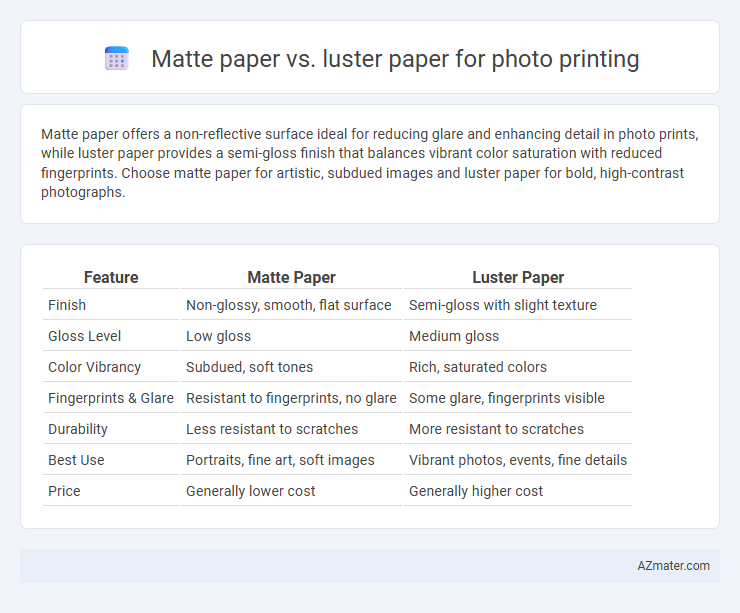Matte paper offers a non-reflective surface ideal for reducing glare and enhancing detail in photo prints, while luster paper provides a semi-gloss finish that balances vibrant color saturation with reduced fingerprints. Choose matte paper for artistic, subdued images and luster paper for bold, high-contrast photographs.
Table of Comparison
| Feature | Matte Paper | Luster Paper |
|---|---|---|
| Finish | Non-glossy, smooth, flat surface | Semi-gloss with slight texture |
| Gloss Level | Low gloss | Medium gloss |
| Color Vibrancy | Subdued, soft tones | Rich, saturated colors |
| Fingerprints & Glare | Resistant to fingerprints, no glare | Some glare, fingerprints visible |
| Durability | Less resistant to scratches | More resistant to scratches |
| Best Use | Portraits, fine art, soft images | Vibrant photos, events, fine details |
| Price | Generally lower cost | Generally higher cost |
Understanding Matte and Luster Photo Papers
Matte photo paper features a non-glossy, smooth surface that reduces glare and fingerprints, making it ideal for framing and professional presentations where reflection is a concern. Luster photo paper, often described as semi-gloss or pearl finish, offers a subtle sheen that enhances colors and sharpness while minimizing fingerprints better than glossy paper. Choosing between matte and luster depends on the desired finish, with matte providing a muted, elegant look and luster delivering vibrant, eye-catching prints with durable texture.
Visual Differences: Surface Texture and Finish
Matte paper features a smooth, non-reflective surface that minimizes glare, offering a soft, muted appearance ideal for fine art prints and subtle color tones. Luster paper combines a slightly textured finish with a glossy sheen, enhancing color vibrancy and contrast while reducing fingerprints and glare compared to glossy paper. The choice between matte and luster paper impacts the final image presentation, where matte delivers a classic, understated look, and luster provides vivid colors with a professional, semi-gloss finish.
Color Reproduction and Vibrancy
Matte paper offers a softer finish with less glare, resulting in subdued color reproduction and lower vibrancy, ideal for a classic, muted aesthetic. Luster paper provides a semi-gloss finish that enhances color saturation and contrast, delivering more vibrant and dynamic images with a professional photo-quality feel. For photo printing where vivid colors and sharp details matter, luster paper generally outperforms matte in preserving color depth and brightness.
Suitability for Different Photography Styles
Matte paper offers a smooth, non-reflective surface ideal for black-and-white photography and fine art prints, enhancing subtle details and reducing glare. Luster paper features a slightly glossy finish with vibrant color reproduction and deeper contrast, making it suitable for portrait and wedding photography where vividness and sharpness are crucial. Choosing between matte and luster paper depends on the desired aesthetic, with matte excelling in muted, textured images and luster enhancing bright, dynamic photos.
Handling Glare and Reflections
Matte paper effectively minimizes glare and reflections due to its non-glossy, textured surface, making it ideal for viewing photos under bright lighting conditions. Luster paper offers a slight sheen that enhances color vibrancy but may produce moderate reflections when exposed to direct light sources. For photo printing where glare reduction is paramount, matte paper ensures clearer visibility without compromising image quality.
Fingerprints, Smudges, and Durability
Matte paper resists fingerprints and smudges more effectively than luster paper, making it ideal for handling without visible marks. Luster paper offers a subtle sheen that enhances color vibrancy but is more prone to fingerprint smudging due to its slightly glossy finish. In terms of durability, matte paper is less susceptible to scratches and glare, while luster paper provides moderate protection with a balance between sheen and surface resilience for photo prints.
Framing and Display Considerations
Matte paper reduces glare and reflections, making it ideal for framing under glass in brightly lit rooms, as it minimizes distracting light spots and enhances image detail visibility. Luster paper features a semi-gloss finish that offers vibrant colors and deep blacks, but its slight sheen can cause reflections when displayed behind glass, potentially affecting viewing angles. Choosing between matte and luster paper depends on the lighting environment and framing options, with matte preferred for glare-sensitive displays and luster for stand-alone or non-glass presentations where vividness is prioritized.
Cost Comparison: Matte vs Luster Paper
Matte paper typically costs less than luster paper due to its simpler coating process and lower demand in professional photography markets. Luster paper, often favored for its vibrant color reproduction and glossy finish, commands a higher price, reflecting the enhanced quality and durability. When budgeting for photo printing, choosing matte paper can reduce expenses without significantly sacrificing image quality, making it a cost-effective option for bulk prints or casual use.
Best Use Cases for Matte Photo Paper
Matte photo paper excels in producing glare-free prints, making it ideal for photos displayed in bright environments or under direct lighting. Its smooth, non-reflective surface enhances detailed textures and rich color depth without unwanted shine, perfect for portrait photography and fine art prints. Matte paper also resists fingerprints and smudges, ensuring long-lasting, durable prints suited for framing and archival purposes.
Ideal Scenarios for Luster Photo Paper
Luster photo paper offers a perfect balance between glossy and matte finishes, making it ideal for vibrant portrait prints and wedding photos where rich color depth and reduced glare are essential. Its subtle texture minimizes fingerprints and reflections, which is beneficial for professional galleries or display environments with varied lighting conditions. Optimal for enhancing skin tones and fine details, luster paper produces sharp images with a semi-gloss finish that excels in both color saturation and durability.

Infographic: Matte paper vs Luster paper for Photo printing
 azmater.com
azmater.com